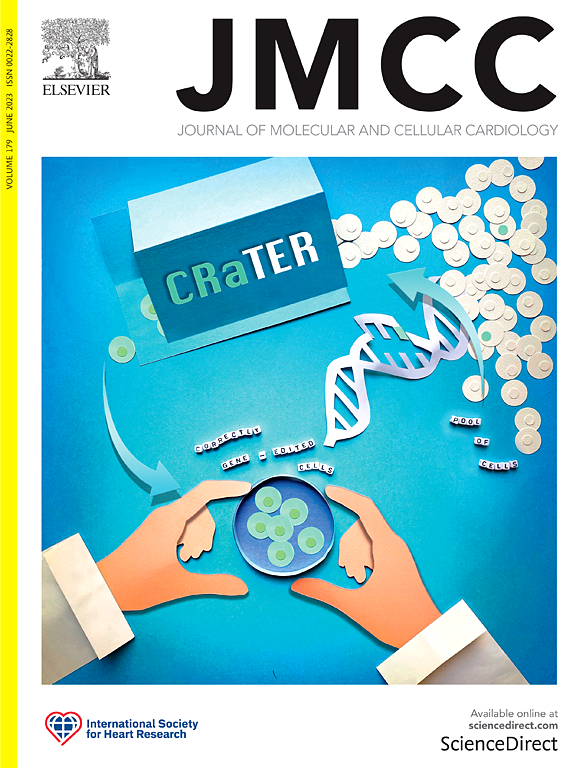肌凝蛋白-肌动蛋白过桥非依赖性肌节长度诱导皮肤心肌纤维Ca2+敏感性变化:肌凝蛋白头的作用。
IF 4.7
2区 医学
Q1 CARDIAC & CARDIOVASCULAR SYSTEMS
引用次数: 0
摘要
肌节长度依赖性激活(LDA)是参与Frank-Starling机制在心脏输出量的搏动调节中必不可少的。通过LDA,心脏在更长的肌节长度上增加Ca2+对心肌收缩的敏感性,导致相同Ca2+水平下的最大力增强。尽管它在正常和病理状态下都很重要,但LDA的分子机制,特别是肌节长度(SL)诱导肌丝Ca2+敏感性增加的起源,仍然是难以捉摸的。本研究的目的是探讨舒张期肌凝蛋白头部状态变化的作用,以及在无膜(剥皮)大鼠心肌纤维中,强发力交叉桥(XB)作为sl诱导的肌钙蛋白Ca2+敏感性的决定因素的影响。用含有荧光团修饰的心肌肌钙蛋白C、cTnC(13C/51C)AEDANS-DDPM的肌钙蛋白复合物和重组心肌肌钙蛋白I (cTnI)突变体ΔSP-cTnI重组心肌肌钙蛋白I (cTnI)突变体,其中cTnI的开关肽(Sp)被非功能肽链取代,部分阻断肌球蛋白与肌动蛋白的生力反应。我们使用重建的心肌纤维作为平台,研究皮肤心肌纤维内肌钙蛋白的Ca2+敏感性如何响应肌球蛋白-肌动蛋白xb状态的变化。肌肉力学和荧光测量清楚地显示,在存在或不存在强XB的情况下,sl诱导的肌钙蛋白Ca2+敏感性的增加相似,这表明sl诱导的Ca2+敏感性变化与产生XB的力与细丝的反应无关。mavacamten是一种选择性肌凝蛋白运动抑制剂,已知可促进肌凝蛋白头部从弱肌动蛋白结合状态(ON或无序放松(DRX)状态)过渡到有序关闭状态(off或超放松(SRX)状态),它的存在削弱了观察到的sl诱导的肌钙蛋白Ca2+敏感性的增加,而不管XBs的存在,这表明肌凝蛋白头部在弱肌动蛋白结合状态下的存在,对于Ca2+-肌钙蛋白感知肌节拉伸是必不可少的。用含有工程TEV可消化突变体cTnI和cTnT的肌钙蛋白重建的剥皮心肌纤维的结果表明,观察到的SL对Ca2+敏感性的影响可能涉及肌动蛋白/Tm簇区域弱结合的肌球蛋白头部与肌钙蛋白相互作用,与cTnT- t1和cTnT- t2残基182-229相互作用。机械拉伸效应可能随后通过肌钙蛋白的IT臂和cTnI的n端传递到N-cTnC。我们的研究结果强烈表明,sl诱导的舒张期肌球蛋白-肌钙蛋白的潜在相互作用,而不是强肌球蛋白-肌动蛋白XBs,可能是肌丝LDA的重要分子机制。本文章由计算机程序翻译,如有差异,请以英文原文为准。

Myosin-actin crossbridge independent sarcomere length induced Ca2+ sensitivity changes in skinned myocardial fibers: Role of myosin heads
Sarcomere length-dependent activation (LDA) is essential to engaging the Frank-Starling mechanism in the beat-to-beat regulation of cardiac output. Through LDA, the heart increases the Ca2+ sensitivity of myocardial contraction at a longer sarcomere length, leading to an enhanced maximal force at the same level of Ca2+. Despite its importance in both normal and pathological states, the molecular mechanism underlying LDA, especially the origin of the sarcomere length (SL) induced increase in myofilament Ca2+sensitivity, remains elusive. The aim of this study is to interrogate the role of changes in the state of myosin heads during diastole as well as effects of strong force-generating cross-bridges (XB) as determinants of SL-induced Ca2+ sensitivity of troponin in membrane-free (skinned) rat myocardial fibers. Skinned myocardial fibers were reconstituted with troponin complex containing a fluorophore-modified cardiac troponin C, cTnC(13C/51C)AEDANS-DDPM, and recombinant cardiac troponin I (cTnI) mutant, ΔSP-cTnI, in which the switch peptide (Sp) of cTnI was replaced by a non-functional peptide link to partially block the force-generating reaction of myosin with actin. We used the reconstituted myocardial fibers as a platform to investigate how Ca2+ sensitivity of troponin within skinned myocardial fibers responds to sarcomere stretch with variations in the status of myosin-actin XBs. Muscle mechanics and fluorescence measurements clearly showed similar SL-induced increases in troponin Ca2+ sensitivity in either the presence or the absence of strong XBs, suggesting that the SL-induced Ca2+ sensitivity change is independent of reactions of force generating XB with the thin filament. The presence of mavacamten, a selective myosin-motor inhibitor known to promote transition of myosin heads from the weakly actin-bound state (ON or disordered relaxed (DRX) state) to the ordered off state (OFF or super-relaxed (SRX) state), blunted the observed SL-induced increases in Ca2+ sensitivity of troponin regardless of the presence of XBs, suggesting that the presence of the myosin heads in the weakly actin bound state, is essential for Ca2+-troponin to sense the sarcomere stretch. Results from skinned myocardial fibers reconstituted with troponin containing engineered TEV digestible mutant cTnI and cTnT suggest that the observed SL effect on Ca2+ sensitivity may involve potential interactions of weakly bound myosin heads with troponin in the actin/Tm cluster region interacting with cTnT-T1 and residues 182–229 of cTnT-T2. The mechanical stretch effects may then be subsequently transmitted to the N-cTnC via the IT arm of troponin and the N-terminus of cTnI. Our findings strongly indicate that SL-induced potential myosin-troponin interaction in diastole, rather than strong myosin-actin XBs, may be an essential molecular mechanism underlying LDA of myofilament.
求助全文
通过发布文献求助,成功后即可免费获取论文全文。
去求助
来源期刊
CiteScore
10.70
自引率
0.00%
发文量
171
审稿时长
42 days
期刊介绍:
The Journal of Molecular and Cellular Cardiology publishes work advancing knowledge of the mechanisms responsible for both normal and diseased cardiovascular function. To this end papers are published in all relevant areas. These include (but are not limited to): structural biology; genetics; proteomics; morphology; stem cells; molecular biology; metabolism; biophysics; bioengineering; computational modeling and systems analysis; electrophysiology; pharmacology and physiology. Papers are encouraged with both basic and translational approaches. The journal is directed not only to basic scientists but also to clinical cardiologists who wish to follow the rapidly advancing frontiers of basic knowledge of the heart and circulation.

 求助内容:
求助内容: 应助结果提醒方式:
应助结果提醒方式:


